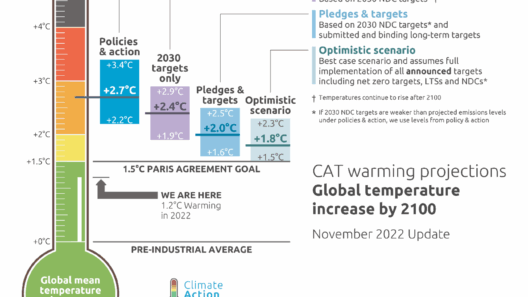As the sun sets on our beautiful blue planet, a profound yet tragic transformation unfolds beneath the waves. The oceans are not merely vast expanses of water; they are intricate ecosystems teeming with life and diversity. Unfortunately, global warming has become a relentless specter haunting these underwater realms, casting a long shadow over countless sea creatures. The struggle of marine life against the repercussions of rising temperatures and altered habitats epitomizes the broader narrative of climate change—a saga of resilience in the face of adversity.
Oceans cover more than 70% of the Earth’s surface, serving as critical habitats for myriad species. From flamboyant coral reefs, often likened to underwater rainforests, to the mysterious depths of the abyss, where bioluminescent creatures dazzle in the dark, these environments boast remarkable biodiversity. However, the warmth engendered by human-induced climate change is unraveling this intricate tapestry, threatening not only the survival of individual species but also the delicate balance of entire ecosystems.
At the heart of this crisis are coral reefs, often described as the architects of marine biodiversity. They provide shelter, food, and breeding grounds for a vast array of organisms. Yet, rising sea temperatures have led to widespread coral bleaching, a phenomenon akin to a mass exodus from a vibrant city. When stressed by heat, corals expel the symbiotic algae (zooxanthellae) that give them color and nutrients. This not only leads to the stark white wasteland of bleached corals, but also disrupts the entire food web that relies on these vital structures. With corals declining at an alarming rate, scientists estimate that we may lose up to 90% of the world’s corals by 2050 unless significant action is taken.
Moreover, the oceans serve as a storage basement for carbon dioxide, with higher levels causing acidification. This chemical transformation can be likened to a disconcerting alchemy, turning seas from teeming nurseries to unsafe havens. Marine organisms, particularly shellfish and some species of plankton, are experiencing the repercussions acutely; the very shells that protect them are becoming increasingly difficult to form. In this escalating battle for survival, the silhouettes of mollusks and crustaceans stand as testament to the resilience of life, yet they reveal a stark vulnerability that cannot be overlooked.
Fish populations, too, find themselves embroiled in this turbulent narrative. As marine habitats change, fish are compelled to migrate in search of suitable environments. This is an unsettling journey reminiscent of ancient nomadic tribes seeking new territories. Depleting fish stocks due to overfishing compound the crisis, leading to a precarious balance in a food chain that is already fraying. Certain species, like cod, have seen their populations dwindle alarmingly, creating ripples in the aquatic ecosystem that reach unimaginable distances.
As sea temperatures rise, the spatial distributions of marine species are shifting; some are fleeing toward cooler waters, while others are merely fading into oblivion. This relentless procession serves as a haunting reminder of the fragility of our interconnectedness. The tuna that once frequented rich spawning grounds are now wandering into uncharted territories, a shift that not only affects biodiversity but also the socionomic fabric of coastal communities reliant on fisheries for sustenance and income. The tales of fishermen echo with concern for future harvests that may dwindle as species adjust their habitats.
Marine mammals, too, face their own daunting odyssey as they navigate these changes. Whales, an iconic symbol of oceanic grandeur, are adjusting their migratory routes as temperatures rise and sea ice diminishes. Their songs resonate through the currents, but the chords of communication are becoming dissonant as shipping traffic and noise pollution increase. The majestic blue whale, once wandering the oceans with regal grace, encounters a cacophony that disrupts its innate call—the serenade of the seas fading against a backdrop of industrial encroachment.
The plight of sea turtles further illustrates the intricate tale of vulnerability and endurance. Rising temperatures are skewing sex ratios, as warmer sands favor the hatching of female turtles—leading to an ecological imbalance. This phenomenon serves as a lingering metaphor of nature’s delicate equilibrium, threatening to tip the scales and disrupt the generational lineage of these ancient mariners. With their critical role in maintaining healthy seagrass beds, the disappearance of sea turtles could lead to cascading consequences throughout marine ecosystems.
However, amidst this grave narrative, there exists a beacon of hope. Conservation efforts, such as marine protected areas, restoration projects, and advocacy for sustainable practices, are beginning to take root. Communities across the globe are uniting to forge resilient pathways forward, championing marine biodiversity and raising awareness to safeguard the oceans. Every initiative becomes a stroke on the canvas of recovery, a reminder that regenerative strategies can bolster resilience against climate change.
In conclusion, the struggle of sea creatures against the relentless tide of global warming is a poignant saga. The animated dance of life beneath the waves faces unprecedented challenges, while the intricate relationships that define marine ecosystems are under siege. As we stand at the brink of irreversible change, it is imperative to acknowledge and act upon the vital interconnectedness of life on Earth. The sea, with its myriad inhabitants, beckons us to listen to its whispered urgencies and to secure a future where the balance of life can persist. As we gaze into the depths, let us remember that the struggle of these remarkable creatures is not just their own; it is a clarion call for humanity to nurture and protect our planet’s precious oceans.







